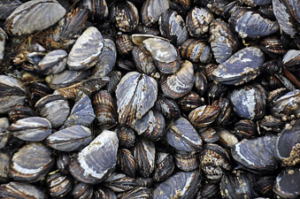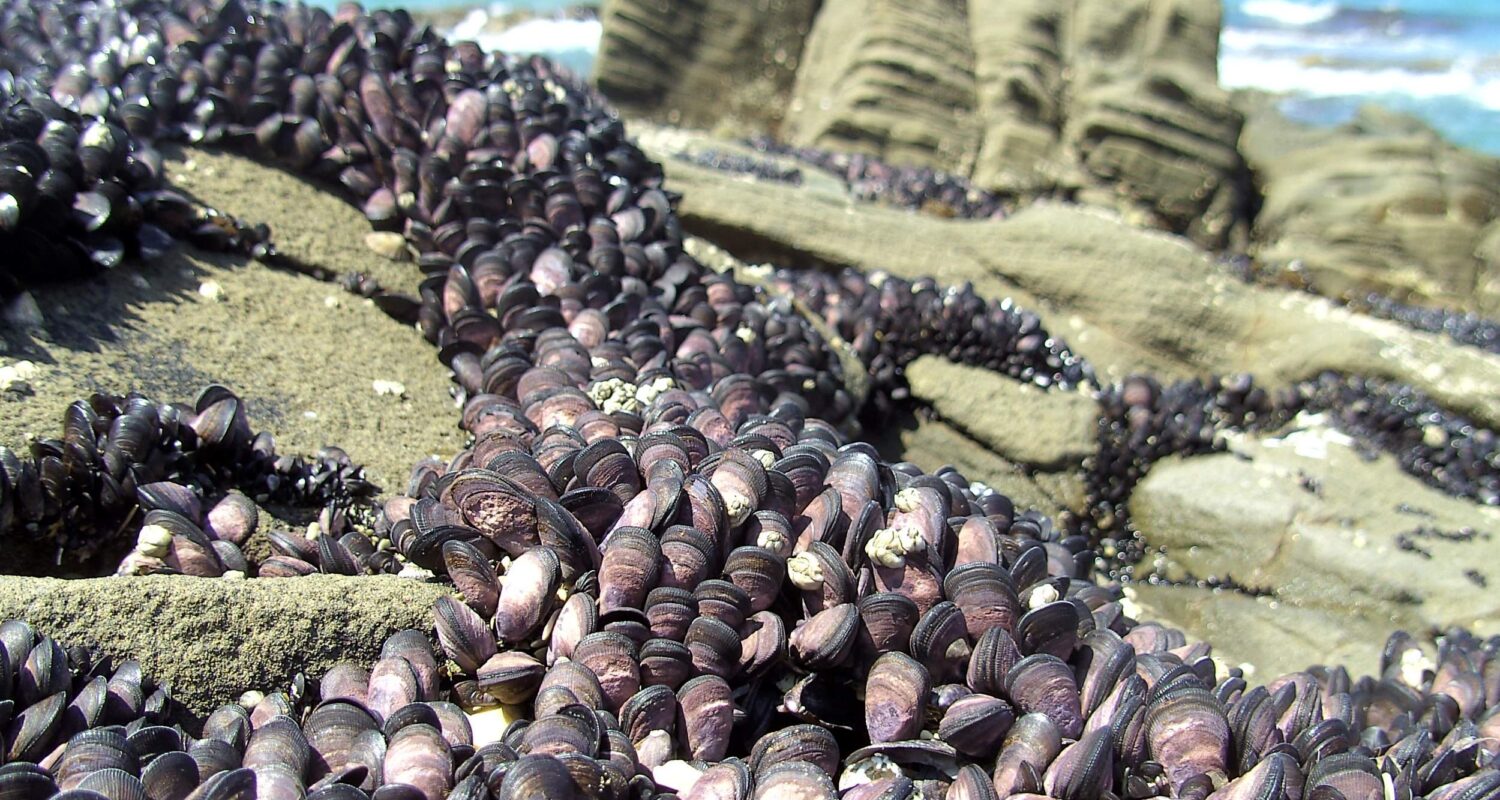Cameron, N.M., Scrosati, R.A., Valdivia, N. & Z.D. Meunier. Global taxonomic and functional patterns in invertebrate assemblages from rocky-intertidal mussel beds. Sci Rep 14, 26 (2024). https://doi.org/10.1038/s41598-023-50549-8
Meet the mussels
Mussels live worldwide in rocky intertidal habitats, which are stony habitats on the beach that are affected by tides. Mussels are known as ecosystems engineers, which are organisms that create, modify, destroy or maintain a habitat. They are able to do this because mussels create huge beds that are habitats for other. Mussels play several key roles including: provide hiding places, protect organisms from drying out or washing away during low tide, catch food for others, and finally their shells provide hard material for organisms to attach. They play a vital role to other invertebrates, organisms without a backbone, in the intertidal zone.

Researchers can study biodiversity, or the diversity of organisms in a specific habitat, in several ways. One way is to define organisms into taxonomic groups. A taxonomic group is a way to group common organisms by ancestry. A common taxonomic level we evaluate is species, but there are a total of eight levels of taxonomic groups. The most specific is species, and as you reach higher levels of taxonomy, more organisms get grouped together. For example, the taxonomic group mammals contains about 5500 species. Researchers use taxonomic groups at various levels to study biodiversity, by examining how many organisms in each taxonomic level are in a habitat.
Biodiversity at its finest
To understand the impact of mussels on biodiversity in rocky intertidal habitats, researchers in this study collected public access data about invertebrates found in rocky intertidal habitats around the world. Researchers collected from the west Pacific (Japan and New Zealand), east Pacific (Washington, Oregon and Chile), west Atlantic (Nova Scotia, Uruguay and Argentina) and the east Atlantic (Ireland and South Africa). The sites are all temperate climates, the mid-latitudes with distinct seasons and temperature changes, where mussel beds thrive. The data collected contained information about what species were found in each intertidal habitat site, which the team then compared and categorized into various levels of taxonomic groups.
In total, researchers used information from about 413,000 total invertebrates in mussel beds around the world. The highest number of identified species occurred in Washington (242) while sites in New Zealand had the lowest number of identified organisms (26). There were distinct regional similarities in the composition of organisms in each mussel bed depending on hemisphere and habitat location in the ocean. For example, barnacles were always present in mussel beds in the eastern Pacific and South Africa, while roundworms and earthworms were always present in the northeastern Atlantic. Additionally, the total density of each taxonomic group differed regionally, which contributed to the distinctions. Researchers believe that the regional differences were driven by the oceanography of the area, such as global currents.
To make all sites similar for comparison, the team settled on a total of 28 common taxonomic groups to divide the 413,000 organisms into. When grouped into the 28 common taxonomic groups, all the mussel beds showed similar types of the taxonomic groups present. This indicates to researchers that the mussel beds are essentially hosting the same types and levels of diversity, taxonomically.

Then, the team analyzed the difference in the types of organisms, divided by traits, such as feeding, body type or how the organisms move. These traits can tell the team a lot in a few words, such as how an organism obtains their food sources, how they resist damage/stress, and how/if they can escape danger. Comparing how many organisms have each trait is another way to compare the sites. Researchers found that the total density presence of each trait group was distinct. For example, Nova Scotia and Ireland hosted a relatively high amount of soft-bodied organisms (soft organisms without hard exoskeletons), crawling organisms, and decomposers (organisms that break down dead or decaying organisms) relative to other sites, while Japan hosted no decomposers or firm bodies, bodies with spines were only present in Chile and Washington, and Washington hosted the only parasites of all the site surveys. However, each community contained generally the same traits, parasites and bodies with spines being the only exceptions.
The bottom line: it’s not selfish to love shellfish
This global study supports the idea that mussels host similar communities worldwide in rocky intertidal habitats, and that these communities differ relatively only in density and abundance rather than actual composition. Additionally, this allows scientists to make informed decisions. If future restoration were necessary and certain organisms were lost, scientists could utilize this study to make knowledgeable organism replacements and understand the role of mussels in their ecosystem. Biodiversity is an essential part of keeping the ecosystem healthy, so it is paramount to understand, support and preserve the diversity of rocky intertidal habitats.


Amazing work!!
Great read! I didn’t know mussels were such a cornerstone species in these environments!